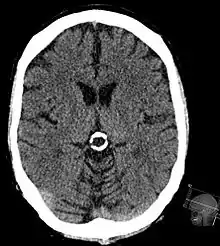Pinealiszyste
Als gliale Pinealiszyste oder Pinealiszyste wird eine gutartige Veränderung im Bereich der Zirbeldrüse (Glandula pinealis) bezeichnet.
| Klassifikation nach ICD-10 | |
|---|---|
| D35 | Gutartige Neubildung sonstiger und nicht näher bezeichneter endokriner Drüsen |
| D35.4 | Epiphyse [Glandula pinealis] [Zirbeldrüse] |
| ICD-10 online (WHO-Version 2019) | |
Pinealiszysten sind sehr häufig;[1] in der ganz überwiegenden Zahl handelt es sich um einen klinisch asymptomatischen Zufallsbefund, dem kein Krankheitswert zukommt.[2] Große Pinealiszysten können eine Abflusstörung des Nervenwassers mit Entwicklung eines Hydrocephalus verursachen;[3] nur in Einzelfällen ist ein Zusammenhang mit dem Auftreten plötzlicher Todesfälle hergestellt worden.[4]
Pathologie
Histologisch handelt es sich um einen pseudozystischen Hohlraum, dessen Wand von Astrozyten mit zahlreichen Rosenthal-Fasern gebildet wird; eine epitheliale Auskleidung besteht nicht.
 Verkalkte Pinealiszyste (Ebene um 20° geneigt zur Transversalebene, computertomographisch erstelltes Röntgenbild)
Verkalkte Pinealiszyste (Ebene um 20° geneigt zur Transversalebene, computertomographisch erstelltes Röntgenbild) Verkalkte Pinealiszyste desselben Falls, hier dargestellt auf einem Schnittbild in sagittaler Rekonstruktion (CT)
Verkalkte Pinealiszyste desselben Falls, hier dargestellt auf einem Schnittbild in sagittaler Rekonstruktion (CT) Pinealiszyste
Pinealiszyste
(Sagittalschnitt in MRT, magnetresonanz-tomographisch erstelltes Kernspinresonanzbild) Pinealiszyste (Pfeil) als Zufallsbefund bei der Obduktion, samt Zentimetermaß (photographisches Bild)
Pinealiszyste (Pfeil) als Zufallsbefund bei der Obduktion, samt Zentimetermaß (photographisches Bild)
Einzelnachweise
- Y. Pu u. a.: High prevalence of pineal cysts in healthy adults demonstrated by high-resolution, noncontrast brain MR imaging. In: AJNR Am J Neuroradiol. 2007;28(9), S. 1706–1709. PMID 17885233
- M. R. Fetell u. a.: Non-neoplastic pineal cysts. In: Neurology. 1991;41(7), S. 1034–1040. PMID 2067630
- H. Mena u. a.: Nonneoplastic pineal cysts: a clinicopathologic study of twenty-one cases. In: Ann Diagn Pathol. 1997;1(1), S. 11–18. PMID 9869821
- C. M. Milroy, C. L. Smith: Sudden death due to a glial cyst of the pineal gland. In: J Clin Pathol. 1996;49, S. 267–269. PMID 8675746
Weblinks
- Patienteninformationen und Fallbeispiele der Klinik für Neurochirurgie, Greifswald
This article is issued from Wikipedia. The text is licensed under Creative Commons - Attribution - Sharealike. The authors of the article are listed here. Additional terms may apply for the media files, click on images to show image meta data.